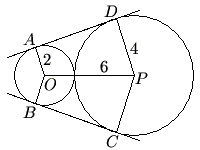Difference between revisions of "2006 AMC 10B Problems/Problem 24"
m (fixed link) |
m |
||
| Line 1: | Line 1: | ||
== Problem == | == Problem == | ||
| − | + | [[Circle]]s with centers <math>O</math> and <math>P</math> have radii <math>2</math> and <math>4</math>, respectively, and are externally tangent. Points <math>A</math> and <math>B</math> on the circle with center <math>O</math> and points <math>C</math> and <math>D</math> on the circle with center <math>P</math> are such that <math>AD</math> and <math>BC</math> are common external tangents to the circles. What is the area of the [[concave]] [[hexagon]] <math>AOBCPD</math>? | |
[[Image:2006amc10b24.gif]] | [[Image:2006amc10b24.gif]] | ||
| Line 7: | Line 7: | ||
== Solution == | == Solution == | ||
| − | Since a tangent line is perpendicular to the radius containing the | + | Since a [[tangent line]] is [[perpendicular]] to the [[radius]] containing the point of tangency, <math>\angle OAD = \angle PDA = 90^\circ</math>. |
| − | Construct a perpendicular to <math>DP</math> that goes through point <math>O</math>. Label the point of intersection <math>X</math>. | + | Construct a perpendicular to <math>DP</math> that goes through point <math>O</math>. Label the point of [[intersection]] <math>X</math>. |
| − | Clearly <math>OADX</math> is a rectangle. | + | Clearly <math>OADX</math> is a [[rectangle]]. |
Therefore <math>DX=2</math> and <math>PX=2</math>. | Therefore <math>DX=2</math> and <math>PX=2</math>. | ||
Revision as of 00:20, 11 November 2006
Problem
Circles with centers ![]() and
and ![]() have radii
have radii ![]() and
and ![]() , respectively, and are externally tangent. Points
, respectively, and are externally tangent. Points ![]() and
and ![]() on the circle with center
on the circle with center ![]() and points
and points ![]() and
and ![]() on the circle with center
on the circle with center ![]() are such that
are such that ![]() and
and ![]() are common external tangents to the circles. What is the area of the concave hexagon
are common external tangents to the circles. What is the area of the concave hexagon ![]() ?
?
![]()
Solution
Since a tangent line is perpendicular to the radius containing the point of tangency, ![]() .
.
Construct a perpendicular to ![]() that goes through point
that goes through point ![]() . Label the point of intersection
. Label the point of intersection ![]() .
.
Clearly ![]() is a rectangle.
is a rectangle.
Therefore ![]() and
and ![]() .
.
By the Pythagorean Theorem:
![]() .
.
The area of ![]() is
is ![]() .
.
The area of ![]() is
is ![]() .
.
So the area of quadrilateral ![]() is
is ![]() .
.
Using similar steps, the area of quadrilateral ![]() is also
is also ![]()
Therefore, the area of hexagon ![]() is
is ![]()










